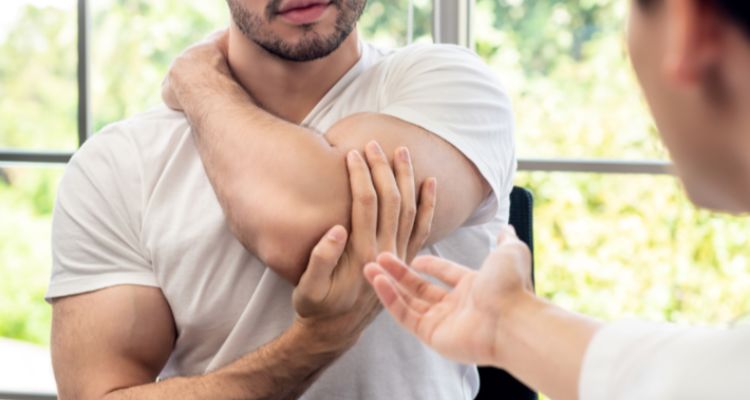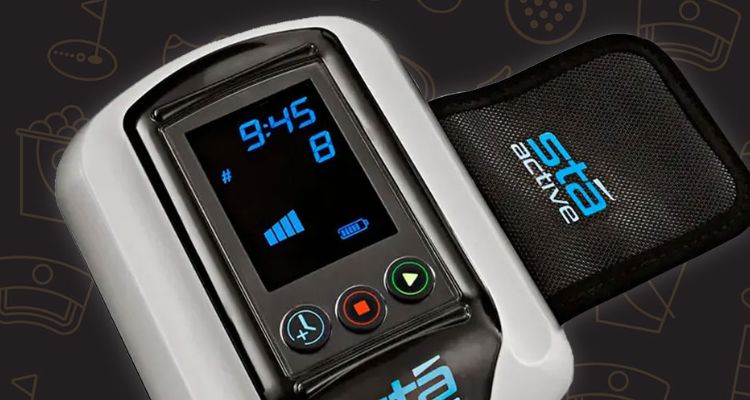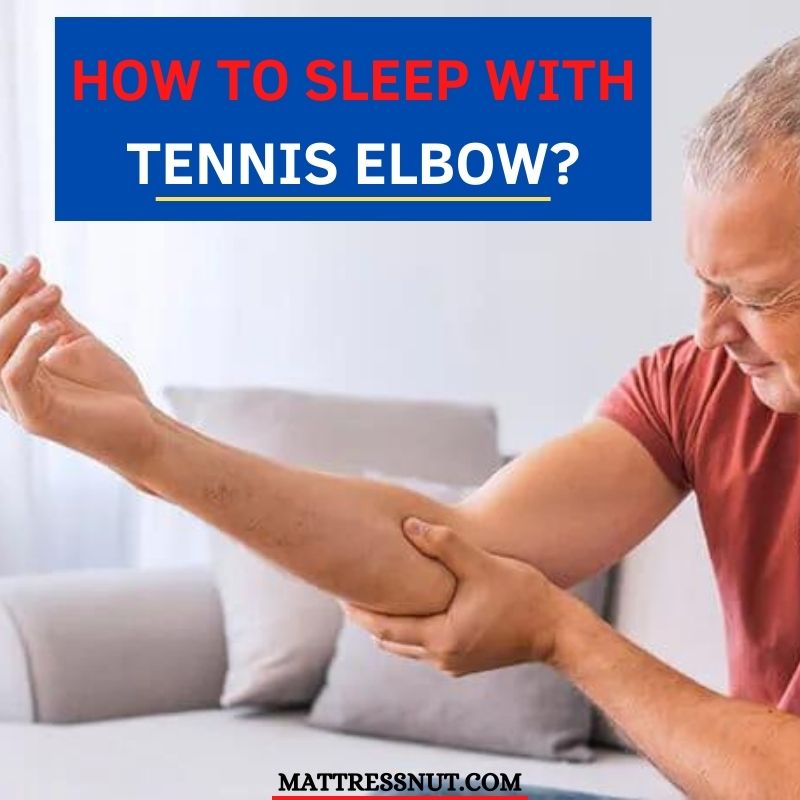The tennis elbow is pretty real and tends to get worse with time. The worst part is that it can even be painful when you rest your arm or are motionless during sleep. Now, this is where things get tricky and uncomfortable.
On its own, tennis elbow can be pretty uncomfortable. But things start to mess up when it begins to interfere with your sleep. Let’s dive into more detail about the matter and find out how to effectively manage tennis elbow and prevent it from causing sleep disruptions.
Tennis Elbow Causes & Symptoms
Sleeping with this sort of pain can be pretty irksome. Tennis elbow begins just as a regular intermittent discomfort, but it slowly becomes a pain with daily arm movements involving activities like holding a coffee cup or brushing your teeth.

According to a study, most people in the US already struggle to sleep in our 24/7 interconnected society. Experts state that adults should get 7 to 9 hours of sleep, or it will cause many health issues, including hypertension, diabetes, obesity, etc. Almost 10 million people in the US suffer from this condition each year.
This pain in your elbow can be caused by any activity, including gaming, tennis, exercising, biking, tennis, golf, or other crafting activities. The overall effects on your arms remain the same.
That’s why it is also known as an overuse injury, and it happens because of the repetitive movements of your tendons and muscles in your forearm. With this muscle overuse, light microscopic tears occur within the muscles.
And with these tears, inflammation, irritation, and tendon degeneration occurs, resulting in pain over time. Other symptoms include:
- A problem in lifting various items
- Weak gripping strength
- Dull ache
- Finger numbness
- Soreness or stiffness in the elbow
- Sharp aches when you use your west or forearm
You can experience all these symptoms no matter what you’re doing, from playing tennis and using your computer mouse to lifting your briefcase, bumping elbows, and even shaking hands with others. And most sufferers of this pain have to deal with it even at night when it worsens and disrupts their sleep.
How to Fall & Stay Asleep with This Condition
As lack of sleep or sleep disruption can cause many other health issues, it’s always important to ensure that you find a way to rest properly and deal with this condition.
There are a few options you can try and see if they work or not. But if nothing seems to work, you can always contact your physician.
Using heat before you go to sleep
You have to make sure you use some heat before going to sleep. Be sure to stimulate blood circulation and muscle relaxation by heating your elbow with a hot compress or a warm bath. You can use a heating pad or any quality topical cream like Ice Hot or Bengay.
Wearing a loose-fitting sleeve on your elbow
You need to skip any tight braces or compression sleeves that can restrict blood circulation. Go for any light neoprene socks with their toe area cut out. With the loose support, the sock can conserve heat and assist in stabilizing your forearm by reducing pressure on those injured muscles and tendons.
Using pillows to support your elbow
You need to add some external support with the help of some pillows and place them right under your affected arm. It will help decrease any stress on the affected area.
Sleeping on the back or your unaffected side
It’s a no-brainer, but sleeping on your back can be troubling if you are a stomach or a side sleeper (also check the top rated mattresses for back sleepers). Falling asleep on a side you are not used to can be tough. If you tend to be a combo sleeper, you will move into a position where you might end up on your injured side, and this causes pain.
Treating Your Tennis Elbow
You need to address tennis elbow if you don’t want any sleep disruptions to occur due to these conditions. Some medical devices are available on the market that you can use to treat torn tissues in your elbow causing the pain.
One of the most effective devices you can use is the Fiix Elbow, an FDA-registered device. It automates a clinically proven procedure known as instrument-assisted mobilization in soft tissue or IASTM.
This instrument delivers repetitive strokes to your affected forearm tension and reduces adhesions or scar tissue. Moreover, it helps blood flow and oxygenation and stimulates collagen synthesis to boost the healing process.

You will only wear such a device for around 10 minutes and about three times a week for about eight weeks straight. Apart from that, you will have to perform some simple exercises.
This regimen can help you overcome this condition as you can develop your tendon. Increase the overall strength of your forearm. As a result, you will be able to get better sleep at night without any disruption caused by pain.
Is a Pain-Free Position Best for Sleeping with Tennis or Golfer’s Elbow?
Unfortunately, there is no such position, and it’s all just a myth. You might be able to sleep in one position while dealing with this condition. But if you tend to roll into a different position during sleep, it’s back to square one.
If you find yourself in pain and wake up from sleep, you might be sleeping in a position that doesn’t work well with your injury. There are a few positions that you should avoid with tennis elbow, which perhaps is the best thing you can do to alleviate pain.
Worst positions to sleep in with tennis elbow
Without a doubt, the worst positions to sleep in when dealing with tennis elbow are,
Sleeping with your affected arm overhead or under your pillow/head
You have to make sure you relax your affected arm as much as possible. There is no way resting it on your forehead or under the pillow will help you with this condition. So, be sure to rest your affected arm properly.
Lying on the affected arm
You are wrong if you are lying on your affected arm to make it more comfortable by applying some pressure. Your affected arm needs blood flow, stimulation, and relaxation. And the best way to do it is to wear a warm sleep and rest it as much as possible.
Excerpts concluded that your sleep position could be a potential aggravator that can delay the healing some acute injuries resulting in chronic pain. Moreover, keeping your arm down while sleeping is for tennis elbow. But this study doesn’t address the matter of sleep disruption.
There is another concept that you need to keep in mind, and that is acute elbow lesions. According to the study, mechanical pressure can aggravate that initial lesion during sleep night after night. With this aggravation, healing can be delayed, which explains the severity of pain when the individual gets up in the morning.
But the issue here is that there is no acute lesion in the tennis elbow, at least in most cases. This is because “acute” refers to something sudden and traumatic, while “lesion” refers to a wound over an abnormal or pathological tissue area.
Should I Wear Compression Sleeves at Night for Tennis Elbows?
Wearing compression sleeves might not be a good idea because the affected area needs to be relaxed and not compressed. Therefore, you need to consider wearing a brace instead of compression sleeves.
Be sure not to wear the brace all day and night because it prevents your arm from making its natural movements and can also halt the healing process by restricting blood flow.
Key Takeaways
1. Understanding Tennis Elbow
Tennis elbow is characterized by discomfort or pain due to overuse of tendons and muscles in the forearm. Resulting from repetitive activities, it leads to microscopic muscle tears, which then cause inflammation, irritation, and degeneration of the tendons. Symptoms of this condition include:
- Dull ache
- Weak grip
- Numbness in fingers
- Soreness or stiffness in the elbow
- Sharp pain during forearm activities
Despite its name, tennis elbow isn’t limited to athletes. It can result from various activities like gaming, exercising, and even mundane tasks like using a computer or lifting items.
2. Addressing Sleep Disruption
Managing tennis elbow at night is pivotal to ensure uninterrupted sleep. Here are some strategies:
- Heat Application: Using a heating pad or topical creams like Ice Hot or Bengay before sleep can promote blood circulation and muscle relaxation.
- Loose-Fitting Sleeve: Instead of tight braces, opt for light neoprene socks with toe areas cut out to provide loose support and preserve heat.
- Pillow Support: Position pillows under the affected arm to minimize stress on the injury.
- Sleeping Position: Ideally, sleep on the back or the unaffected side to avoid adding pressure to the injury.
3. Tennis Elbow Treatment
There are various devices and treatments available:
- Fiix Elbow: An FDA-registered device, the Fiix Elbow employs the Instrument-Assisted Soft Tissue Mobilization (IASTM) procedure, delivering repetitive strokes to the affected forearm. This aids in reducing scar tissue and promoting blood flow, hastening the healing process.
4. Debunking Myths: Sleep Positions and Compression Sleeves
There is no definitive “pain-free” position for sleeping with tennis elbow. However, certain positions can exacerbate the pain:
- Avoid Sleeping with the affected arm overhead or beneath the pillow.
- Avoid Lying directly on the affected arm.
While some might consider wearing compression sleeves at night, they may not be ideal. Braces, worn intermittently, can offer better support without hindering blood circulation.
Conclusion:
Sleeping with tennis elbow can be hectic. But you need to make sure that you don’t over-treat the condition. Give your affected arm as much rest as possible, and don’t apply too much pressure to it. You can use some pain relievers according to your doctor’s advice.
References
https://www.npr.org/2022/03/15/1086691330/a-third-of-u-s-adults-are-struggling-to-get-a-good-nights-rest-a-survey-finds
https://www.hopkinsmedicine.org/health/conditions-and-diseases/lateral-epicondylitis-tennis-elbow
https://www.mayoclinic.org/diseases-conditions/tennis-elbow/symptoms-causes/syc-20351987
https://orthoinfo.aaos.org/en/diseases–conditions/tennis-elbow-lateral-epicondylitis/
Sleep with tennis elbow FAQs
How do you sleep with a severe tennis elbow?
Rest assured not to sleep on your affected arm. Provide as much support as possible to your affected arm with pillows. You can wear a brace while sleeping and prevent your arm from moving away from the body.
How do you treat tennis elbow at night?
The best way to treat your tennis elbow is to use pillows to support your affected area and a brace to keep it close to your body. This way, you can relax the muscles in your affected arms, speeding up the recovery process.
Is tennis elbow worse at night?
Pain might worsen over time, but it might worsen at night. This is especially true if you sleep in the wrong positions and apply unnecessary pressure on your affected arm. But as you try to relax and your attention is not divided, you will feel that your pain has worsened at night.
What is the fastest way to cure tennis elbow?
You need to rest properly and avoid activities that might cause elbow pain. You can use some pain relievers and can also use ice. Furthermore, keep your affected arm close to your body while sleeping, but don't apply any pressure to it.

